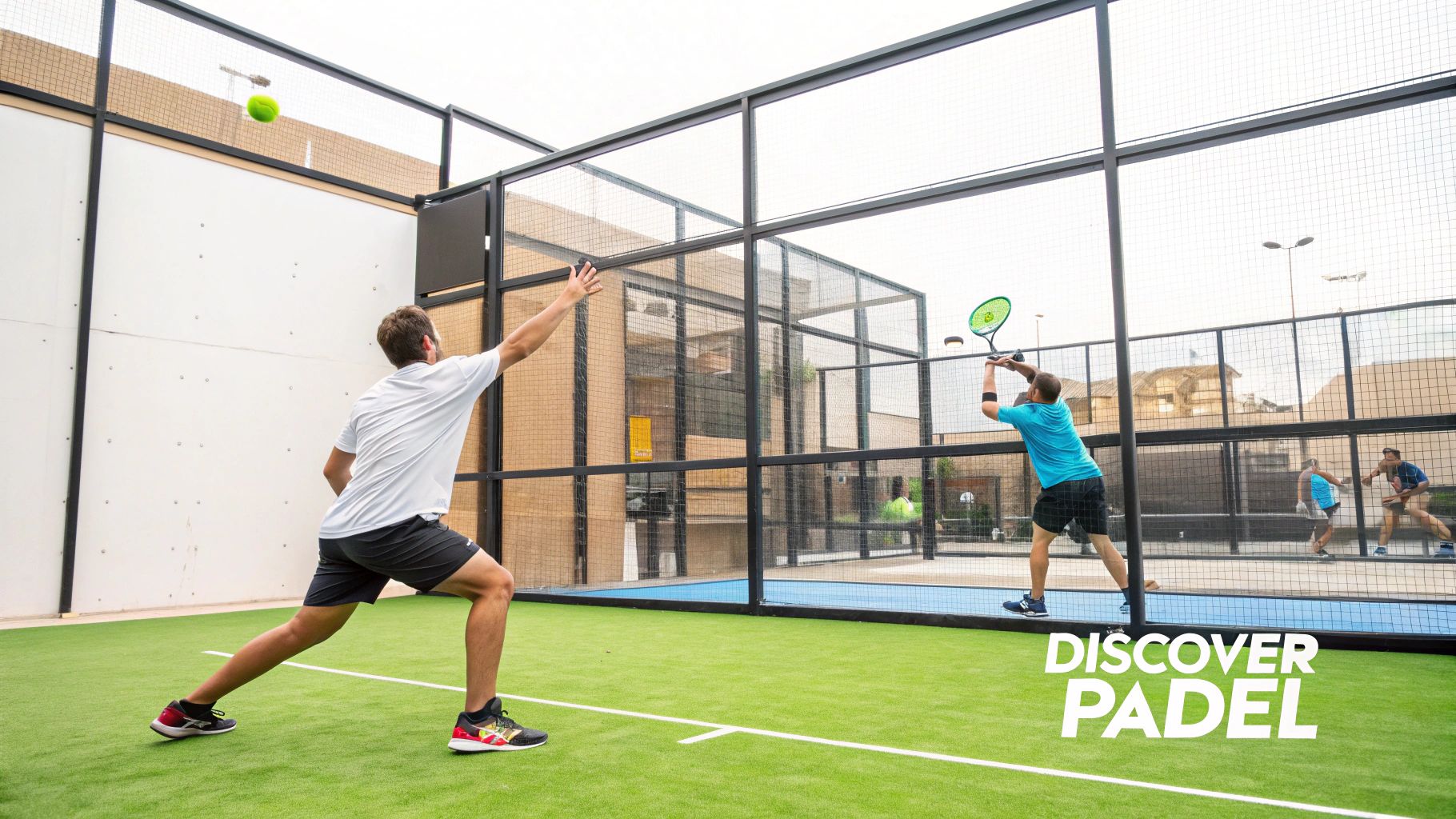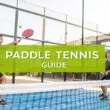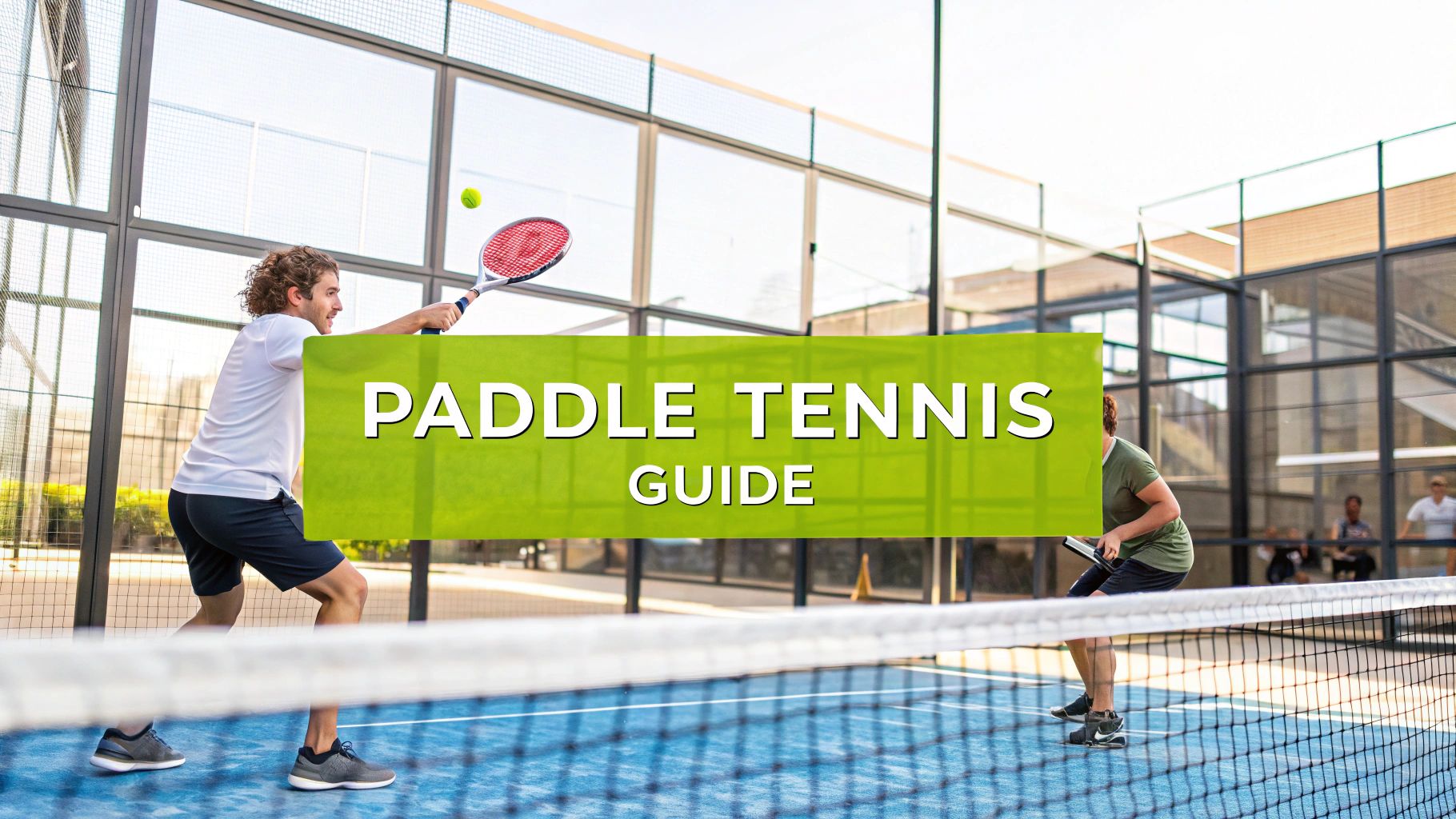Ever heard of a sport that blends the non-stop rallies of tennis with the clever, wall-bouncing action of squash? That's paddle tennis in a nutshell, though these days you'll almost always hear it called Padel. It’s an incredibly social, fast-paced game played in doubles on a smaller, enclosed court where the walls are very much in play.
So, What Is Paddle Tennis (Padel) Really?

Don't mistake Padel for a simple, shrunken-down version of tennis. It's a sport all its own, with a unique court and gameplay that completely change the dynamic. Think of it as a hybrid that rewards smarts and strategy over sheer power. The court is the real game-changer here, creating a whole new playbook for players to learn.
The court's design is what truly defines Padel. At roughly 20 meters by 10 meters, a Padel court is about a third of the size of a standard tennis court. This smaller space is boxed in by glass and mesh walls, which aren't just boundaries—they're a strategic part of the game. Players use them to bounce the ball, adding an exciting dimension that demands quick reflexes and crafty shot placement.

Buy the best padel gear to level up your next game!
CHECK OUT this deal from Padel Market!Get ready to take your game to the next level with the latest padel gear from Padel Market! Fast EU and Worldwide Shipping
The Core Concepts of Padel
At its heart, Padel is built on a few key concepts that make it incredibly easy to pick up but surprisingly deep to master. For starters, forget about those powerful overhead serves you see in tennis. Padel begins with a simple, underhand serve. This one small tweak lowers the barrier to entry and gets longer, more exciting rallies going from the very first point.
Here are the key ingredients that make Padel what it is:
- The Walls Are Your Ally: The glass back walls and side fences are your best friends. Experienced players use them to return tough shots, create wild angles, and completely outfox their opponents.
- Teamwork is Everything: Padel is an exclusively doubles game, so talking and moving with your partner is just as critical as your own paddle skills. You win or lose together.
- Strategy Over Power: Because the court is smaller and the ball has a bit less bounce, Padel is more like a game of high-speed chess. It rewards players who can anticipate the next shot, find open space, and use clever placement instead of just trying to hit the ball as hard as possible.
Padel’s design naturally leads to longer rallies and a much more social vibe. The close proximity of the players and the constant action make it an absolute blast for everyone, from complete beginners to seasoned pros.
The Accidental Invention of Padel

Unlike sports with deep, ancient roots, Padel's story is a modern one, born from a classic problem: not enough space. It all started back in 1969 with a Mexican businessman, Enrique Corcuera, who wanted a tennis court for his holiday home in Acapulco. The only catch? He just didn't have the room for a full-sized court.
His solution was to build a smaller version, but that created a whole new headache—balls constantly flying into his neighbor's property. So, Corcuera did something brilliantly simple: he enclosed the court with walls. Without even trying, he had just invented a brand-new game. The walls weren't just boundaries anymore; they became an active part of the sport, leading to longer, more strategic rallies. This happy accident laid the foundation for Padel as we know it.
From a Backyard to the World Stage
The game could have easily remained a private hobby if not for one of Corcuera’s guests, a Spanish aristocrat named Alfonso de Hohenlohe. After visiting Mexico and falling hard for this new game, he knew he had to bring it back to Spain with him.
By 1974, de Hohenlohe had built the first two official Padel courts at the exclusive Marbella Club, introducing the sport to Europe’s high society. This was the moment Padel started its journey from a quirky backyard invention to a global phenomenon. You can dive deeper into its fascinating beginnings by exploring the history of Padel’s origins.
From the swanky clubs of Marbella, the sport's popularity exploded. It quickly built a passionate following across Spain before hopping over to Argentina, where it became a national obsession.
What began as a space-saving fix in Acapulco grew into a sport loved for its social vibe and strategic depth, captivating millions of players across Latin America and Europe.
Today, that accidental invention is still on a roll, with new courts and clubs popping up all over the world, cementing its place as a beloved international sport.
Gearing Up For The Padel Court

Stepping onto a Padel court for the first time is an awesome feeling, and having the right gear can make all the difference. Your main piece of kit is the Padel paddle itself, which is a world away from a standard tennis racket. It’s a solid, stringless paddle riddled with holes to cut down on air resistance and give you a better feel for the ball.
The shape of your paddle is a huge deal and really shapes how you play. It's a bit like picking a class in a video game—each one has its own special skills.
- A diamond-shaped paddle has more weight at the top, packing a serious punch for those overhead smashes.
- A round paddle keeps the sweet spot right in the center, giving you a ton of control for placing your shots perfectly.
- The teardrop shape is the best of both worlds, a solid all-rounder that blends power and control.
Paddles, Balls, and Playing The Walls
Next, let's talk about the Padel ball. At a glance, it looks just like a tennis ball, but there’s a key difference: it has slightly less internal pressure. This simple tweak means the ball bounces a bit lower and slower, which is exactly what helps create those long, fun rallies that get beginners hooked on the game. You just have more time to get to the ball and think about your next shot.
Finally, you have to think of the court itself as part of your equipment. Those glass back walls and wire-mesh fences aren’t just there to keep the ball in play; they're your secret weapons. Learning how to play the ball off the glass is a fundamental Padel skill, turning what looks like a defensive scramble into a clever attacking move.

Buy the best padel gear to level up your next game!
CHECK OUT this deal from Padel Market!Get ready to take your game to the next level with the latest padel gear from Padel Market! Fast EU and Worldwide Shipping
If you want to dive deeper into the gear, you should check out this great guide on essential paddle tennis equipment.
The right gear doesn't just help you play; it helps you understand the game's unique strategy. From the paddle's shape to using the court walls, each piece is designed to create a dynamic and accessible experience.
Don't forget about your shoes, either. Padel is full of quick stops, sudden sprints, and sharp turns. You’ll need court shoes with a killer grip to keep you from sliding around and to support all those side-to-side movements. The right footwear keeps you agile and, more importantly, safe on the court.
How to Play: Padel Rules and Scoring Explained
One of the best things about padel is just how fast you can pick it up. The rules are straightforward and feel natural, even if you’ve never held a racket before. You can get the hang of the basics in just a few minutes, and if you know tennis, the scoring will be instantly familiar.
The single most important rule to get right from the start is the serve. Unlike tennis, every single serve in padel is underhand. You have to let the ball bounce once behind the service line, then hit it at or below your waist. This simple motion makes it so much easier for beginners to kick off a rally without any pressure.
Mastering The Scoring System
The scoring in padel is a carbon copy of tennis, which means you're already halfway there. You win a game by following the exact same point progression:
- First point: 15
- Second point: 30
- Third point: 40
- Fourth point: Game
If both sides hit 40, you’ve got a "deuce." From here, one team has to win two points in a row to close out the game. The first point is called "advantage," and the second one clinches the game. It’s a classic system that keeps matches tight and exciting.
Using The Walls to Your Advantage
Now for the really fun part: the walls. The glass walls are what give padel its unique strategic flavor. A ball is still live after it bounces on the court and then hits any of the walls. That means you can let the ball rebound off the back or side glass before you hit it back to your opponents.
This one rule completely changes the game. A shot that would be a lost point in tennis becomes a strategic opportunity in padel. It leads to way longer rallies and opens the door for creative shots you just can't pull off in other racket sports.
For a deeper dive, check out the complete rules of paddle tennis to really master every detail of the game.
Padel Vs Other Racket Sports
With so many racket sports popping up, it's easy to get them confused. Is Padel just a tiny version of tennis? Is it another name for pickleball? While they all share some DNA, Padel serves up a completely unique experience that really sets it apart from its cousins. The biggest differences come down to the court, the gear you use, and the game-changing role of the walls.
For long-time tennis players, switching to Padel means shifting your brain from pure power to clever placement. The smaller court and underhand serve take the sting out of those aggressive, high-speed serves you see in tennis, forcing a more strategic, rally-driven game. You can dive deeper into the specific adjustments in this detailed comparison between Padel and tennis.
Pickleball players, on the other hand, will find the court dynamics are a whole different world. Pickleball is played on a compact, open court with a plastic ball. Padel's enclosed court and pressurized ball create a much faster, more three-dimensional game where the walls become your best friend (or your worst enemy).
Padel Vs Tennis Vs Pickleball At a Glance
To really get a feel for what makes Padel tick, it helps to see it side-by-side with the sports it's most often compared to. This quick breakdown highlights the core elements that give each game its distinct flavor.
| Feature | Paddle Tennis (Padel) | Traditional Tennis | Pickleball |
|---|---|---|---|
| Court Size | 20m x 10m, enclosed | 23.77m x 10.97m, open | 13.4m x 6.1m, open |
| Racket/Paddle | Solid, perforated paddle | Strung racket | Solid paddle |
| Ball Type | Depressurized tennis ball | Standard tennis ball | Plastic wiffle ball |
| Walls in Play | Yes, glass and mesh | No | No |
| Serve Style | Underhand only | Overhand or underhand | Underhand only |
As you can see, Padel's enclosed court and specialized equipment carve out a sweet spot that makes the game both incredibly easy for beginners to pick up and deeply strategic for seasoned pros. It’s a fantastic blend of action and tactics.
This infographic breaks down some of the key rules that really define Padel gameplay.

This visual guide shows how the underhand serve, familiar scoring, and wall-play combine to create a truly unique racket sport experience.
Why Padel Is Exploding In Popularity
Padel isn't just another racket sport; it's a full-blown social phenomenon. Hailed as the world's fastest-growing sport, its secret sauce is a simple but potent mix: it's incredibly easy to pick up, naturally social, and a perfect match for our busy lives.
Unlike tennis, where mastering the basics can take months of coaching, padel has a wonderfully gentle learning curve. Most newcomers find themselves having fun rallies within their very first hour on the court. The underhand serve and smaller court size immediately remove the biggest hurdles, making the game instantly rewarding.
This accessibility is a huge part of what gets people hooked.
Social by Design
There's another key ingredient to padel's magic: it's almost always played in doubles. This setup isn't just a rule; it's the core of the experience. It naturally encourages communication, teamwork, and a friendly, vibrant atmosphere you don't always find in more individual sports.
Because the court is smaller, players are closer together, making it easy to chat and laugh between points. The game feels more like a social gathering than a grueling athletic contest.
The smaller court footprint also makes it a dream for urban areas. Clubs can fit multiple padel courts into the space that a single tennis court would take up, creating more opportunities to play.
This blend of an easy start and a built-in social scene has created a powerful engine for growth. The numbers speak for themselves: padel now has over 30 million amateur players in nearly 150 countries.
In Spain, it’s a cultural cornerstone, with more than 11,000 padel courts and around two million active players. You can read more about how padel took over the world on TheWeek.com to see just how massive this sport has become.
Got Questions About Padel? We've Got Answers
So, you're getting into the world of Padel, and a few questions are probably rattling around in your head. That's totally normal. Getting some quick, clear answers can make all the difference before you even set foot on the court.
Here are a couple of the most common things beginners ask.
Is Padel The Same As Pickleball?
Nope, they're two completely different games, though they often get mixed up. Padel is played on a larger, enclosed court where you can strategically play the ball off the glass walls. Pickleball uses a smaller, open court and a plastic wiffle ball, which leads to a totally different feel and style of play.
Do I Have To Play Doubles?
Yes, Padel is almost always played as doubles, with two players on each team. This setup is a core part of the game's strategy and what makes it such a social sport. While you might stumble upon a singles court once in a blue moon, they're incredibly rare and not how the game is officially played.
Padel is often called one of the easiest racket sports to pick up. The underhand serve is a breeze to learn, the court is smaller so there's less running, and the slower ball makes for longer, more satisfying rallies right from the start.
Here at Padel Rumors, we've got all the resources you need to get good at the game, from beginner guides to in-depth gear reviews. Ready to find the perfect racket or sharpen your technique? Dive into our articles at https://www.padelrumors.com.








